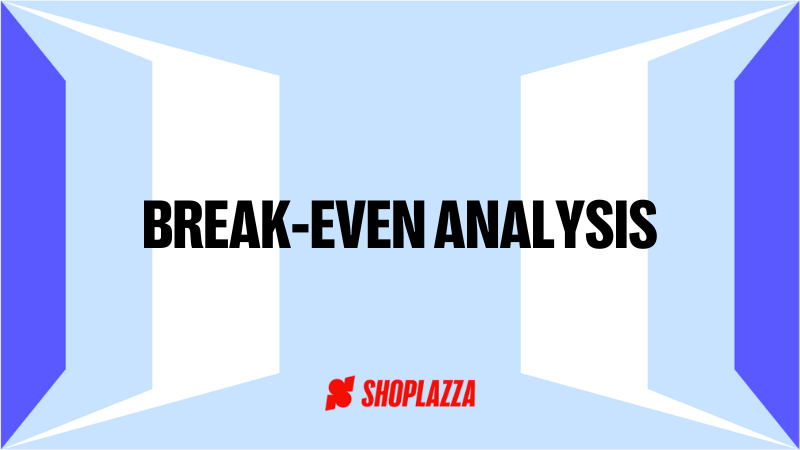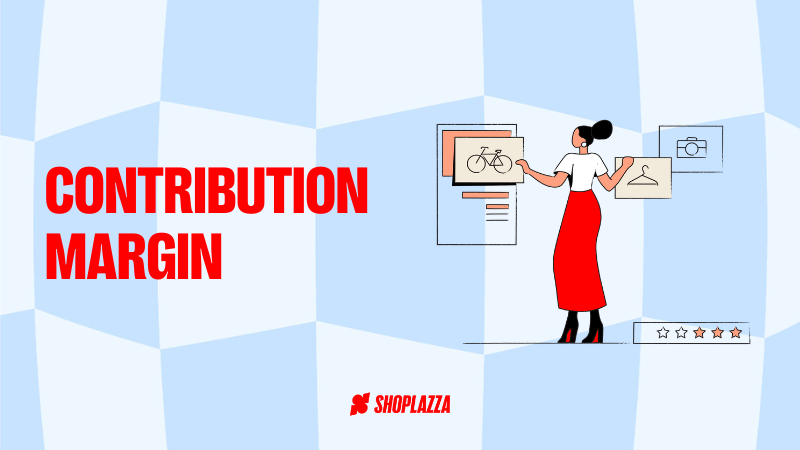
So you’ve decided to take the plunge and launch your online store. You’ve chosen an ecommerce platform, picked the perfect store domain and you’re already working on branding, too. Social media profiles are all created, and you’ve settled on the best fulfillment practices.
Now all that’s left to do is pray that traffic starts trickling in and that sales actually materialize. Right?
Well, kinda. The thing is, lighting up a couple of candles and wishful thinking isn’t really gonna set up your store for success.
The truth is, starting an online business is hard work. It involves a lot of planning, a lot of careful consideration, a lot of estimates and a lot of numbers. And though some people say that you gotta spend money to make money, when it comes to managing a business, you also need to make sure that you’re at least earning back what you spent to set up shop in the first place. That way, you’ll break even and then you can start to plan accordingly for the next steps.
This is where a break-even analysis comes in. Keep reading to find out a bit more about what break-even point is and how it can help your business.
What is break-even analysis?
A break-even analysis is an important calculation for small businesses working on virtually any type of niche. Whether you're selling jewelry, plants, home decor or even subscriptions, a break-even analysis can help you understand how much you need to make in sales to avoid getting into debt.
To generate this analysis, you must take into account all the fixed costs and variable costs of your business (which we’ll detail below), together with the store products’ average sales price. The goal is to find out the exact number of units you need to sell in order for you not to lose the initial money you invested.
This is an important estimate for entrepreneurs who are just launching their businesses, especially when we consider just how big a part money―or better yet, the lack of it―plays in this scenario.
According to a report released by Small Business Trends, about 18% to 31% of businesses fail within one or two years, and the main reason is money: 38% simply run out of cash.

The reality is grim, but it also points to something that’s easily overlooked: Most entrepreneurs simply do not assess their business ventures to see whether or not they really are making money.
It’s understandable. You need to pay attention to so many details when you open an online store that it’s easy to lose track of something. And once those first sales come in, you may get a bit carried away and end up interpreting that as a sign that it’s time to either start amping your (still very limited) budget for paid advertising or, even worse, skyrocketing prices just because the greedy bug bit you.
And when you least expect it, bam: You’re at risk of losing your business. But a break-even analysis can help avoid those exact pitfalls.
📈 Simply put: A break-even analysis is a calculation that will indicate how many products you need to sell to make back the initial investment you’ve put into your store.
What is break-even point?
As we’ve mentioned above, small businesses should conduct a break-even analysis to find out how many units of a product they need to sell in order to break even―i.e., in order to make back that initial investment made in the business itself.
However, while it’s true that a break-even analysis will help you find out how many units of a product you’ll need to sell, we should also keep in mind that there’s a fancier and more thorough way to say that.
Ready?

Here it is: A break-even analysis will help you calculate the break-even point, which indicates the exact moment when you’ve gained back the investment you made in your store. The sales you make after you reach that break-even point are your profits.
Understanding where your break-even point is located within your estimates can be of great help when planning for the next steps because it’ll dictate things like:
- Your paid traffic strategy: If you need to sell a high number of units and your store is still not where you’d like to be in terms of organic reach, then perhaps it’s necessary to focus your attention on paid channels such as Google Ads.
- Shipping fees: Finding the ideal shipping solution can be hard because you need to balance out the product’s selling price and the carrier’s fees. If you’re planning on working with free shipping, for instance, the selling price will likely be higher—which means that, depending on how much you originally invested, you’ll probably need to sell a higher number of units to achieve your break-even point.
- Your own working hours: You know all those sleepless nights you spent working on your site’s about page and reading about how to promote an ecommerce store? All of those are working hours, and you need to make sure the amount of hours you’re clocking in remains feasible for your goals. It’s no use spending 75 hours per week on a store if your break-even analysis is indicating a completely different scenario.
📈 Simply put: The break-even point is that sweet spot where a business is breaking even. It signals the point where your initial investment has paid off, and you’re no longer losing money. However, you’re still not making money (in other words, making a profit) either.
How to do a break-even analysis
There are three big factors to consider when you conduct a break-even analysis: Your average selling price, and your fixed and variable costs.
- The average selling price is an estimate of all your products’ selling prices. This is easier to calculate if you’re managing a niche business, such as a cosmetics store, but it can be a bit tricky to pinpoint when dealing with a home decor store or even a garment store that sells a wide range of products.
- Fixed costs refer to all those costs that you have on a monthly basis and aren’t subject to changes. You need to factor in everything that you spend to make your business happen, and we do mean everything: internet provider fees, payment provider fees, domain register, ecommerce platform subscription, warehousing costs, email provider subscription…
- Variable costs, unlike fixed costs, can change depending on each month’s performance and how much you sell. They can encompass working hours, costs with packaging, courier fees, processing fees per payment, how much you had to spend with returned items and so on. As a rule of thumb, the more you sell, the higher your total variable cost will be.
🧮 Check out this example: If you own a bakery and are responsible for delivering those delicious baked goods by car, then you’re dealing with two different types of costs. You have both fixed costs (annual licensing and maintenance fees) and variable costs (how much you’re spending per month on gas).
Pretty straightforward? Hmm, not so much.
A lot of entrepreneurs actually struggle with listing all of their fixed costs and their variable costs, too. This can happen for reasons that range from merely forgetting one thing or another to completely overlooking what managing a business actually entails.
That’s why our tip for nailing your break-even analysis is to take it easy. Spend at least one month just really paying attention to all the bills you’re paying, and then create a working document to list all your fixed costs and all of your variable costs.
Then, when the next month comes along, keep track of all the variable costs and fixed costs again and jot them down on that document. You’ll notice that you’ve probably skipped one or two of them during the first month—and that’s totally ok.
Keep tracking your costs and then dive into calculating your break-even point when you feel like you’ve gained a deeper overview of your fixed and variable costs.
🧮 Remember: You won’t get an accurate break-even point if you don’t figure out your total fixed costs and your total variable costs first.

🔢 How to find a break-even point
Now that you know what fixed costs and variable costs are, it’s time we introduce you to our break-even point calculator―or, more accurately, our break-even point formula. Check it out:
break-even point 🟰 total fixed costs ➗ ( total variable costs per unit ➖average sales price per unit)
Let’s put this formula to use because, well, not everybody is good with numbers (I know I’m not):
Let’s say you’ve just opened an online store to sell enamel pins and want to figure out what your break-even point is.
After conducting a thorough analysis of your spending, you identified that:
- Fixed costs amount to $750
- Average sales price is $8
- Variable cost per unit is about $15
This means that your break-even analysis will look something like this:
break-even point 🟰 750 ➗ (15 ➖ 8)
break-even point 🟰 750 ➗ 7
break-even point 🟰 107
This means that, in order for your store to break even, you’ll need to sell about 107 enamel pins. Once you reach 108 pins sold, you’ll start making money.
🧮 A pro tip from Shoplazza: Dropshipping businesses tend to have a lower variable cost because the suppliers are the ones handling costly steps such as packaging and shipping

🔢 How to determine a store’s average sales price
Apart from listing your fixed costs and figuring out your product’s variable cost, you’ll also need to pinpoint your average selling price, also known as your average sales price.
This is basically an estimate of the average price your customers are paying for products. In the example above, for instance, your store might be selling different pins for prices ranging from $4 to $11.
To figure out this estimate, you need to apply the formula below:
total revenue you earned when selling your product (per month) ➗ number of units sold (per month)
So if your revenue totalled $750 and you sold 90 pins in January, that means your average sales price is $8.30.
🧮 A pro tip from Shoplazza: When figuring out your selling price, take a look at your competitors to see how much they’re charging for similar products. Also, remember to factor in the variable cost for each product.
🔢 Bonus tip: Don’t forget the contribution margin
Who would’ve guessed that another great ally for conducting a break-even analysis and identifying an average selling price would be… another calculation?
Well, it is. And its name is contribution margin.
A business contribution margin symbolizes the money you have left in the bank after the total variable cost is paid. Ideally, the higher the contribution margin, the more profitable a business is.
How to calculate your business contribution margin
It’s really easy, actually:
total revenue ➖ variable costs
Oh, and get this: You can use your contribution margin to pay for your total fixed costs! That way, you can create a system where all your expenses are interlinked, which makes for smooth management.

How can a break-even analysis help my business?
Apart from being a great accounting and planning tool, a break-even analysis can also help you with plenty of other aspects that go into play when managing a business.
Generally speaking, a break-even point analysis can help you:
- Have a deeper understanding of your business as a whole: Working with a break-even analysis entails listing all of your fixed and variable costs, which means that you’ll be able to construct an overview of your business and figure out exactly how much it costs you to keep your business open.
- Make smarter decisions: You’ll be better equipped to determine your sales price, set a new net profit goal or maybe even switch suppliers and products.
- Decide when (and how) to expand: If business is booming and you’re thinking maybe it’s time to expand, a break-even analysis will help you find your new break-even point so you can decide whether or not it’s time to make that move.
- Get through debt, or maybe avoid it altogether: Unfortunately, many entrepreneurs don’t have enough clarity on their businesses’ finances and don’t even bother figuring out their break-even point. This is dangerous because it can lead to unwise spending and, ultimately, going into debt. Conducting a thorough break-even analysis is a great tool to avoid this from happening—which also means that it’s a great tool if you’re looking to keep your spending under control.
- Set concrete goals: Wanna invest in a Google Performance Max to boost sales? Increase revenue by 15% until the end of the next quarter? Expand your business with a paid customer service tool? A break-even analysis can help you decide how much money you’ll need to spend—and the exact number of units you’ll need to sell—to make that happen.
- Price your products better: Knowing how to price your products is key to achieving success, no matter what your niche is. With a break-even analysis and a contribution margin ratio in place, you’ll be better equipped to determine what your optimal price should be— and you won’t have to rely on subjective factors such as “Since I like a round number, I’ll go with $20”.
- Establish new partnerships and funding: Having a well-documented and defined break-even point can also help you when you start asking for loans and/or reaching out to other businesses to create partnerships. It’ll help show that you have your finances in order and that your store is a reliable investment.
💵 Wanna know more about funding before you dive a bit deeper into break-even analysis? Check out our video below:
What a break-even analysis can’t do for your business
Now that you know everything you need to take into consideration before you calculate break-even point and conduct a thorough analysis of your monthly costs, it’s also important that you understand this:
A break-even analysis reveals a lot about your business, but it doesn’t reveal everything.
Because you’re dealing with numbers that are derived from very rigid elements such as fixed cost, variable cost and selling price, this analysis doesn’t account for the human behavior that happens outside those numbers.
This means that you won’t be able to use a break-even assessment to:
- Predict product trends that are just starting to appear in your market.
- Anticipate customer behavior regarding marketing campaigns or shopping habits.
- Estimate customer engagement in social media campaigns.
You should also keep in mind that a break-even analysis doesn’t last forever. Your costs and sales will probably vary a lot depending on different factors such as special holidays or a promotion you decide to run. Ideally, try to update your analysis every six months or so.
📈 Speaking of product trends…
Just remember: math is your friend
Contribution margin ratio, fixed costs, break-even analysis, variable cost per unit, unit price, average selling price… It’s a lot, I know. It can also be a bit scary if you’re not really into doing math.
But here’s the thing: Your business’ financial health should always be prioritized—especially if you want to thrive. Looking into all the money you’re spending right now can be overwhelming, but it can be even worse to just wake up one day and realize you’re deep into debt because you didn’t plan accordingly.
By finding your break-even point, you have a much higher chance of finding success.
Happy calculations!



